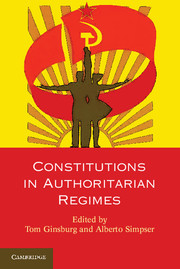Book contents
- Frontmatter
- Contents
- List of Contributors
- 1 Introduction
- Part I The Category
- Part II Constitutional Design in Authoritarian Regimes
- 4 The Political Economy of Autocratic Constitutions
- 5 Authoritarian Constitution Making
- 6 Constitutions in Authoritarian Regimes
- Part III Contents of Authoritarian Constitutions
- Part IV Consequences of Authoritarian Constitutions
- Index
- References
4 - The Political Economy of Autocratic Constitutions
Published online by Cambridge University Press: 05 June 2014
- Frontmatter
- Contents
- List of Contributors
- 1 Introduction
- Part I The Category
- Part II Constitutional Design in Authoritarian Regimes
- 4 The Political Economy of Autocratic Constitutions
- 5 Authoritarian Constitution Making
- 6 Constitutions in Authoritarian Regimes
- Part III Contents of Authoritarian Constitutions
- Part IV Consequences of Authoritarian Constitutions
- Index
- References
Summary
Austria adopted a new constitution in 1934, as did Portugal in 1933, Poland in 1935, Turkey in 1924, and Brazil in 1937 and again in 1967. Besides the fact that these are constitutions adopted in countries characterized by colorful political histories marked by periods of both drastic change and hard-fought stability, what do their constitutions share in common? They were adopted under dictatorship. Although all of these countries eventually transitioned to democracy, these constitutions were not designed to bring about democracy – although some of them served, decades after being adopted, as vehicles for introducing elections and checks on executive authority.
Why do autocrats adopt constitutions? This chapter argues that the fundamental reason is that constitutions can help dictators consolidate power, increase investment, and boost economic development – all while generating a steady flow of rents for themselves and their cronies without empowering challengers that might undermine their authority. This claim may come as a surprise to most readers. It certainly challenges the status-quo, minimalist view that an autocratic constitution is merely window dressing that provides lip service to the rule of law and rights without the sincere intention to enforce them (see Posner and Young 2007, and Chapter 1 of this volume). It also challenges the view that in a dictatorship, a constitution is a formality and afterthought that merely announces that the dictator's authority is supreme and formally and publicly announces his political agenda (Brown 2002).
- Type
- Chapter
- Information
- Constitutions in Authoritarian Regimes , pp. 53 - 82Publisher: Cambridge University PressPrint publication year: 2013
References
- 5
- Cited by



